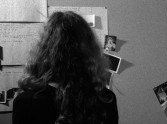



Afterimage… For a New, Radical Cinema
This series of screenings celebrates the publication of The Afterimage Reader (The Visible Press, 2023), a selection of essays, interviews, editorials and filmmakers’ statements from the British film journal. Dedicated to new and radical cinema, Afterimage was published irregularly between 1970 and 1987. The journal has been described, generously, by the critic Nicole Benez as “one of those precious magazines through which the great wind of history blows, one of those rare magazines that made history.” She suggests that “nothing that was politically and aesthetically revolutionary was foreign to Afterimage.” The diverse avant-garde strategies manifested in the films that were discussed in the journal, and are represented in these programmes, bear testament to a vital and turbulent period in the development of independent filmmaking across the world. Afterimage was founded on the principle—as declared in the two divergent editorials in No. 2 (reprinted in The Reader)—of an ongoing commitment to avant-garde cinema, to radical cinema, to “new” cinema understood both aesthetically and politically.
It is important to bear in mind that Afterimage (not to be confused with the US photography journal founded two years later) was born in a completely different context to our current digital age: a time of 16mm prints and projectors; the emergence of magazines devoted to radical and political cinema; the birth of political film collectives and cooperatives for “underground” cinema distribution. It also developed out of the legacy of late sixties political turmoil, student protests in UK and US universities and, of course, the upheavals of May ‘68 in Paris.
Afterimage consistently emphasised the importance of the writings of filmmakers themselves. Over thirteen issues, alongside critical essays by important critics such as Noël Burch and Peter Wollen, the journal published interviews, manifestoes, scripts, theoretical texts and polemical essays from filmmakers, including Jean-Luc Godard, Glauber Rocha, Julio García Espinosa, Hollis Frampton, Paul Sharits, Laura Mulvey, Malcolm Le Grice, Yvonne Rainer, Raúl Ruiz, Derek Jarman and Jan Švankmajer, as well as by important pioneers such as Dziga Vertov and Jean Epstein. Special issues were devoted to Michael Snow and to Jarman, to the relationship between the avant-garde and early cinema, and to visionary animation. Each of the thirteen (one a double issue) was organised around a theme or particular filmmaker.
Presenting this series in the US offers the opportunity to acknowledge how indebted Afterimage was to Film Culture, the journal founded by Jonas and Adolfas Mekas, to which P. Adams Sitney was a contributing editor. Film Culture was a model for us of a partisan publication that was deeply committed to the New American Cinema and its rich avant-garde manifestations of the 60s and 70s.
Afterimage also prided itself on its look, so just as important was the influence of the handsome issues of Film Culture designed by George Maciunas. Inspiration came from the Brakhage issue with its brown paper and corrugated cover and the Warhol issue with coloured paper and elegant full-page images. As a consequence, every issue of Afterimage had a distinctive design that incorporated many film stills and visual ideas. In assembling The Afterimage Reader, Mark Webber (its editor and publisher) integrated some of these design elements into the book.
If the first six issues edited by Simon Field and Peter Sainsbury explored the “two avant-gardes” and contemporary debates in film theory, the new energy brought to the journal by the arrival of Ian Christie as co-editor extended the commitment to radical forms but also looked afresh at early cinema and took us to consider “neglected” figures such as Jean Epstein and Raúl Ruiz, whose films expressed “a notion of cinema as a philosophical machine, a form of discourse in and about the world.”
Michael O’Pray’s contributions as a co-editor of the later issues steered us in the direction of “troublesome cases”: first Derek Jarman, then in the final issue, on the Quays, Jan Svankmajer and other visionary animators.
This series of screenings aims to transmit some sense of the different and changing forms of the international radical cinemas that were celebrated in the pages of the Afterimage journal. Copies of The Afterimage Reader will be available for purchase from the HFA box office throughout the season and can also be purchased from The Visible Press. Original copies of Afterimage can be purchased from LUX. – Simon Field and Mark Webber















